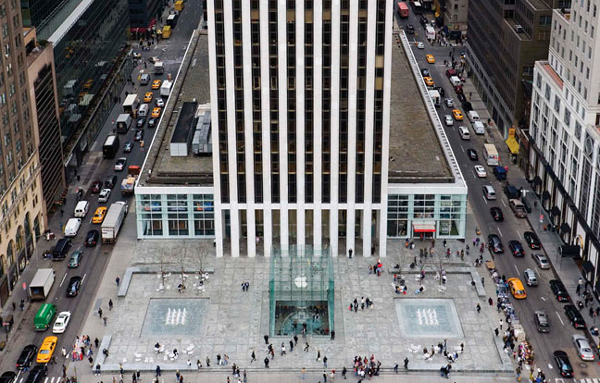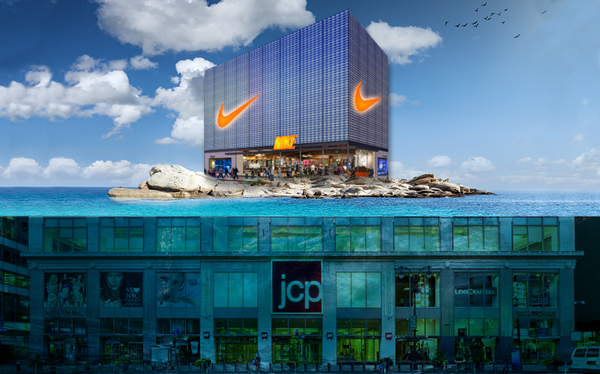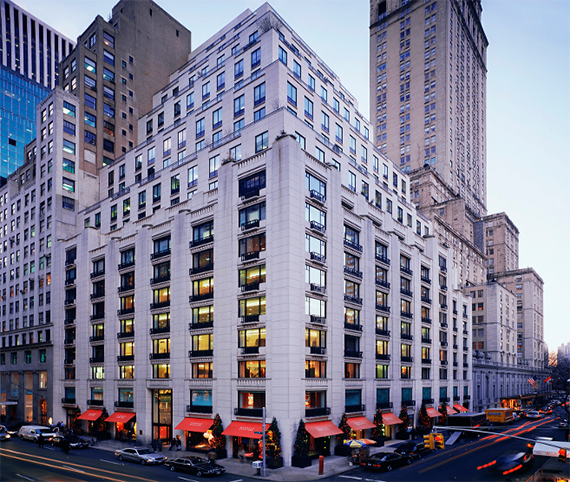Ralph Lauren was the king of “experiential retail” well before the term existed. In the 1980s, the retailer transformed the palatial Rhinelander mansion at 867 Madison Avenue into an elegant and unlikely flagship store, paying as much as $15 million to build out the space. Two decades later, it built an equally majestic Beaux Arts–style mansion from scratch, across the street from the Rhinelander, for a second flagship. Both stores conveyed la dolce vita in a way that allowed Ralph Lauren to sell basic polo shirts and terry cloth bathrobes as must-have luxury goods.
So in 2014, When Ralph Lauren opened its first Fifth Avenue Polo-branded store — complete with coffee shop, bar, and four working fireplaces — there were high hopes for it. But this April, after being beaten down by declining revenues, the company said it would shut the store, in a move it estimated would save $140 million.
“Everyone thought the Polo store was going to be off the charts in terms of creating an environment,” said one real estate player in the know. “And it wasn’t.”
It’s tempting to view the closure as a sign that the retail meltdown has decimated even the toniest stretches of Manhattan retail. But the shifting consumer habits that have put hundreds of stores out to the curb may actually benefit flagships, insiders said. As retailers contract, the last stores they pull out of are their brand-builders in marquee locations like Soho, Times Square and Fifth Avenue.
“Companies will still want to have flagships largely because there will be fewer and fewer stores in general,” said CBRE’s Richard Hodos, who brokered the $500 million Polo lease deal between Ralph Lauren and landlord Coca-Cola. “I don’t think any of the impetus or desire to do flagships will change. I actually think it will grow.”
Dot-com for everything else
Retailers sometimes justify the outsized rents they pay for flagships by defining them as marketing expenses. So in an era where brick-and-mortar retail is more about experience than function, statement stores are exactly what retailers want.
“There’s opportunities on Fifth Avenue and Times Square and maybe even other parts of New York where the showcasing effect or the flagship store is always going to be necessary,” said Robert Futterman, CEO of retail brokerage RKF. “And those stores will always want to be in the most high-profile locations.”
Jared Epstein, a principal at Aurora Capital Associates, said the Polo store’s demise illustrates retail’s current dilemma.
It “seems like a prudent [move] in today’s difficult retail market,” Epstein said. “However,” he added, “I believe once this retail storm subsides, Ralph Lauren may regret giving up one of the greatest retail corners of the world.”
At a shareholder meeting in April, Under Armour CEO Kevin Plank promised investors that the athletic apparel maker’s new 53,000-square-foot flagship store in the General Motors Building at 767 Fifth Avenue, once home to FAO Schwarz, would be “the greatest retail store in the world.” It would also be Under Armour‘s last brick-and-mortar location for quite some time.
“You’re not going to hear of any additional big-box opening happening in the United States for a very long period of time,” Plank said on the call. When Under Armour inked the deal in July 2016, Median Rent On Upper Fifth Avenue was near its peak of $3,500 per square foot.
In February 2016, days after unveiling its second flagship store — a five-story, 58,000-square-foot space boasting a spiral staircase in the heart of Chelsea — Barneys New York CEO Mark Lee said there was a reason the brand had pulled the plug on 23 stores in the last six years.
“Barneys doesn’t belong everywhere,” Lee said, according to Business of Fashion. “It belongs in urban, sophisticated markets. A thriving Barneys.com can cover the rest.”
More flagships are on their way
When stores were still racking up sales and Amazon hadn’t yet choked out high-street retail with same-day shipping, name-brand retailers threw down hefty bets on Manhattan. They paid up to $4,500 a square foot to Lease Space On Upper Fifth Avenue, which had by then surpassed Hong Kong’s Causeway Bay to become the world’s priciest retail address.
Under Armour and Nike went head-to-head for the opportunity to take over the GM Building space. Under Armour ultimately made the deal with Boston Properties, but months later Nike inked what could be a record retail deal at SL Green and Jeff Sutton’s 650 Fifth Avenue. The company will reportedly pay $700 million for the 60,000-square-foot-space over the 15-year term. To land the deal, Sutton and SL Green are said to have paid $70 million to buy out existing tenants Juicy Couture, Godiva and Devon & Blakely.

Retail at the GM Building
Apple also embarked on a $100 million makeover of its pricey GM Building space, temporarily closing the famed glass cube. And more flagships, including legacy department stores, are coming.
Back in 2012, Nordstrom committed to shelling out more than $400 million to construct a seven-level megastore at the base of Extell Development’s Central Park Tower, the expensive condominium development in New York history. The store is expected to open in 2019.
And Neiman Marcus inked a deal with Related Companies to anchor the Hudson Yards retail complex, taking 250,000 square feet across three floors for its flagship location, which is expected to open in fall of 2018.
But the rents!
While the kings of retail were vying for the priciest pieces of Fifth Avenue and Soho, driving rents skywards, the retail malaise was spreading from suburban malls to urban centers, from national chains to designer retailers.
Manhattan wasn’t immune. The city’s priciest corridors are facing their own impending corrections, said CBRE’s Hodos, and the reason is simple: rents are out of whack. As of spring 2017, the median rent on the retail corridor checked in at $3,427 per square foot, according to the Real Estate Board of New York.
“On Fifth Avenue rents need to come down 50 percent,” Hodos said. ”No retailer I know of can make money with that kind of rent.”
Take the Polo store, for example. The total deal for the 16-year lease at 711 Fifth Avenue was $500 million, starting at about $25 million a year. “They said, ‘Look, too much is being spent on this one location,’” said Mike Oliverio, who was head of real estate at Ralph Lauren when the store closed. “Yes it’s a flagship, yes it creates the aura and halo behind the brand, but it’s just gotten too expensive.”

CBRE’s Richard Hodos
Coca-Cola hasn’t been able to find a new tenant that will pay as much as Polo, which means the retailer is bearing the costs until a palatable sublease deal emerges.
Oliverio, now at Acadia Realty Trust, said rents have kept climbing because landlords need to make good on their investments. “Owners bid up pricing on buildings in key markets, which caused them to need higher rents to justify those higher selling prices,” he said, making it difficult, if not impossible, for tenants.
Ran Eliasaf, the founder of Northwind Group, said a handful of landlords and retailers are causing a wider disconnect.
“A few flashy leases were signed at crazy numbers,” he said. “Some were successful in replicating [those deals], but there’s only X amount of companies willing to pay those prices.”
Milking the location
Many of the premier department stores of yore, including Macy’s And Saks Fifth Avenue—whose grandiose flagship stores are among Manhattan’s crown jewels—have faltered in the last few years. Under pressure from flagging sales or activist investors, several are considering how to unlock value at their flagships.
Hudson’s Bay Company, Which Owns Both Saks Fifth Avenue and Lord & Taylor, has considered putting apartments and office space on top of the Lord & Taylor building at 424 Fifth Avenue. And in June, activist investor Land & Buildings Investment Management, which owns roughly 4.3 percent of Hudson’s Bay, started clamoring for the company to monetize the Saks flagship at 611 Fifth Avenue.
“Hudson‘s Bay is a real estate company, full stop,” Jonathan Litt, founder of Land & Buildings, wrote in a letter to shareholders. “Is the best use of [The Saks Fifth Avenue flagship] location truly a department store? What about a hotel? Or office? Or boutique retail stores [like] Apple and Gucci? Or an internet retailer looking to go upscale through a bricks-and-mortar presence as Amazon appears to be doing with its purchase of Whole Foods?”
Litt recently said that Hudson’s Bay’s real estate is three times more valuable than the value of the firm’s stock.
Meanwhile, at long-suffering Macy’s, Doug Sesler, the company’s new head of real estate, told investors in June that the firm was looking for ways to leverage its most valuable asset, the 34th Street mothership.
“I think everybody and his brother’s come to us in some way and sort of said, ‘Gee, we love this piece of real estate. How do we get a piece of it?’” he said in a shareholder presentation. One idea? To build a park on the roof of the building to attract more visitors.
Even if leveraging prime New York real estate is simply good business, it’s hard to ignore the signs that these once-unassailable brands are struggling. Macy’s announced more than 100 store closures since the beginning of 2017, and is planning to lay off 10,000 workers. Hudson’s Bay is in the midst of a plan to lay off 2,000 workers and has seen revenue slide across its retail fleet.
Of the two department stores still planning their New York debuts, Nordstrom’s existing-store sales fell 4.4 percent in the first quarter, then rallied in the second, but concerns remain over whether the family will take the company private.
Neiman Marcus, too, has struggled to boost revenues amid a restructuring. In June, reports surfaced that the retailer had met with its future landlord Related to discuss a potential merger or investment. Related CEO Stephen Ross denied any talk of a merger.
It’s not only department stores. Even Apple, the golden boy of experiential retail, saw sales slip at its flagship location last year by $100 million.
The high ground
The general feeling, for now at least, seems to be that flagship stores will continue to be valuable – for those who can afford the huge rents.
“The rents might go down, But Fifth Avenue, Madison, Soho? They’re never going away,” said Oliverio.
Vornado Realty Trust recently said its “high street flagship retail” stores account for about 30 percent of its New York business. Steve Roth, the CEO of the firm, recently told his shareholders that flagships were safe despite industry headwinds.
“For flagship retail, this is a pause, a cyclical bump,” Roth said. “For everybody else, it is secular disruption.”

